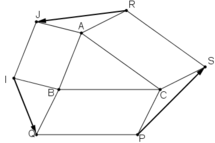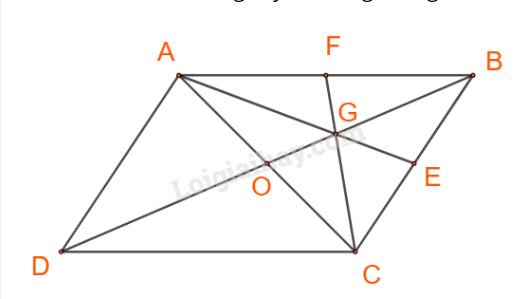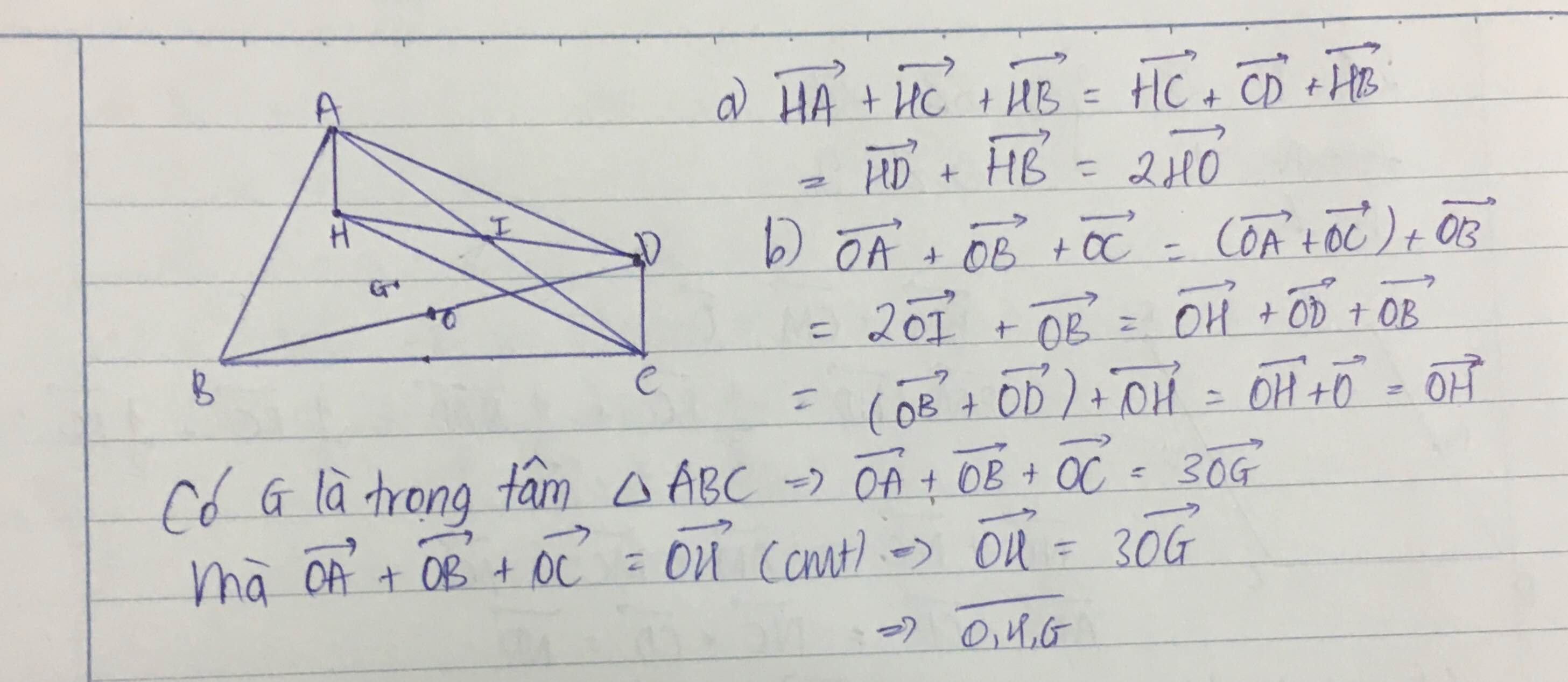Cho tam giác ABC. Bên ngoài của tam giác vẽ các hình bình hành ABIJ, BCPQ, CARS. Chứng minh rằng \(\overrightarrow{RJ}+\overrightarrow{IQ}+\overrightarrow{PS}=\overrightarrow{O}\) ?

Những câu hỏi liên quan
Cho tam giác ABC. Bên ngoài tam giác vẽ các hình bình hành ABIJ, BCPQ, CARS. Chứng minh rằng \(\overrightarrow {RJ} + \overrightarrow {IQ} + \overrightarrow {PS} = \overrightarrow 0 \).
\(\overrightarrow {RJ} + \overrightarrow {IQ} + \overrightarrow {PS} = \left( {\overrightarrow {RA} + \overrightarrow {AJ} } \right) + \left( {\overrightarrow {IB} + \overrightarrow {BQ} } \right) + \left( {\overrightarrow {PC} + \overrightarrow {CS} } \right)\)
\( = \left( {\overrightarrow {RA} + \overrightarrow {CS} } \right) + \left( {\overrightarrow {AJ} + \overrightarrow {IB} } \right) + \left( {\overrightarrow {BQ} + \overrightarrow {PC} } \right) = \overrightarrow 0 + \overrightarrow 0 + \overrightarrow 0 = \overrightarrow 0 \)\(\)(đpcm)

Đúng 0
Bình luận (0)
Cho tam giác ABC. Bên ngoài của tam giác vẽ các hình bình hành ABIJ, BCPQ, CARS. Chứng minh rằng :
\(\overrightarrow{RJ}+\overrightarrow{IQ}+\overrightarrow{PS}=\overrightarrow{0}\)
Có \(\overrightarrow{RJ}+\overrightarrow{IQ}+\overrightarrow{PS}=\overrightarrow{RA}+\overrightarrow{AJ}+\overrightarrow{IB}+\overrightarrow{BQ}+\overrightarrow{PC}+\overrightarrow{CS}\)
\(=\left(\overrightarrow{RA}+\overrightarrow{CS}\right)+\left(\overrightarrow{AJ}+\overrightarrow{IB}\right)+\left(\overrightarrow{BQ}+\overrightarrow{PC}\right)\)
\(=\overrightarrow{0}+\overrightarrow{0}+\overrightarrow{0}=\overrightarrow{0}\). ( Do tứ giác ABIJ, BCPQ, CARS là hình bình hành).
Vậy \(\overrightarrow{RJ}+\overrightarrow{IQ}+\overrightarrow{PS}=\overrightarrow{0}\).
Đúng 0
Bình luận (0)
Cho tam giác ABC. Bên ngoài của tam giác vẽ các hình bình hành: ABIJ, BCPQ, CARS. Chứng minh rằng 

Ta có:
AJIB là hình bình hành nên 

Tương tự như vậy:
BCPQ là hình bình hành nên 
CARS là hình bình hành nên 
Do đó:

Đúng 0
Bình luận (0)
cho tam giác ABC , bên ngoài vẽ các hbh ABIF,BCPQ,CARS. Chứng minh : \(\overrightarrow{RF}+\overrightarrow{IQ}+\overrightarrow{PS}=\overrightarrow{0}\)
\(\overrightarrow{RF}+\overrightarrow{IQ}+\overrightarrow{PS}=\overrightarrow{RA}+\overrightarrow{AF}+\overrightarrow{IB}+\overrightarrow{BQ}+\overrightarrow{PC}+\overrightarrow{CS}=\overrightarrow{0}\)
Đúng 0
Bình luận (5)
ta có : \(\overrightarrow{RF}+\overrightarrow{IQ}+\overrightarrow{PS}\)
\(=\overrightarrow{RA}+\overrightarrow{AB}+\overrightarrow{BF}+\overrightarrow{IB}+\overrightarrow{BC}+\overrightarrow{CQ}+\overrightarrow{PC}+\overrightarrow{CA}+\overrightarrow{AS}\)
\(=\overrightarrow{RA}+\overrightarrow{BF}+\overrightarrow{IB}+\overrightarrow{CQ}+\overrightarrow{PC}+\overrightarrow{AS}\) \(=\overrightarrow{RS}+\overrightarrow{IF}+\overrightarrow{PQ}=\overrightarrow{AC}+\overrightarrow{BA}+\overrightarrow{CB}=\overrightarrow{0}\left(đpcm\right)\)
Đúng 0
Bình luận (1)
Cho tam giác ABC nội tiếp trong đường tròn tâm O. Gọi G,H lần lượt là trọng tâm, trực tâm của tam giác ABC, D là điểm đối xứng với B qua O. a. Chứng minh AHCD là hình bình hành. Suy ra overrightarrow{HA}+overrightarrow{HB}+overrightarrow{HC}2overrightarrow{HO}. b. Chứng minh: overrightarrow{OA}+overrightarrow{OB}+overrightarrow{OC}overrightarrow{OH}. Suy ra O,G,H thẳng hàng. Giúp mình với ạ
Đọc tiếp
Cho tam giác ABC nội tiếp trong đường tròn tâm O. Gọi G,H lần lượt là trọng tâm, trực tâm của tam giác ABC, D là điểm đối xứng với B qua O. a. Chứng minh AHCD là hình bình hành. Suy ra \(\overrightarrow{HA}+\overrightarrow{HB}+\overrightarrow{HC}=2\overrightarrow{HO}\). b. Chứng minh: \(\overrightarrow{OA}+\overrightarrow{OB}+\overrightarrow{OC}=\overrightarrow{OH}\). Suy ra O,G,H thẳng hàng. Giúp mình với ạ
Bài 1 : cho hình bình hành ABCD dựng : overrightarrow{AM} overrightarrow{BA} ;overrightarrow{MN}overrightarrow{DA} ; overrightarrow{NP} overrightarrow{DC}; overrightarrow{PQ} overrightarrow{BC}
CHỨNG MINH overrightarrow{AQ} overrightarrow{0}
bài 2 : cho tam giác ABC bên ngoài các hình bình hành vẽ ABÌ; BCPQ; CARS . CHỨNG MINH : overrightarrow{RF}+overrightarrow{IQ}+overrightarrow{PS} overrightarrow{0}
Đọc tiếp
Bài 1 : cho hình bình hành ABCD dựng : \(\overrightarrow{AM}\)= \(\overrightarrow{BA}\) ;\(\overrightarrow{MN}\)=\(\overrightarrow{DA}\) ; \(\overrightarrow{NP}\)= \(\overrightarrow{DC}\); \(\overrightarrow{PQ}\)= \(\overrightarrow{BC}\)
CHỨNG MINH \(\overrightarrow{AQ}\)= \(\overrightarrow{0}\)
bài 2 : cho tam giác ABC bên ngoài các hình bình hành vẽ ABÌ; BCPQ; CARS . CHỨNG MINH : \(\overrightarrow{RF}\)+\(\overrightarrow{IQ}\)+\(\overrightarrow{PS}\)= \(\overrightarrow{0}\)
bài 1) ta có \(\overrightarrow{AQ}=\overrightarrow{AM}+\overrightarrow{MN}+\overrightarrow{NP}+\overrightarrow{PQ}=\overrightarrow{BA}+\overrightarrow{DA}+\overrightarrow{DC}+\overrightarrow{BC}\)
\(=\left(\overrightarrow{BA}+\overrightarrow{BC}\right)+\left(\overrightarrow{DA}+\overrightarrow{DC}\right)=\overrightarrow{BD}+\overrightarrow{DB}=\overrightarrow{0}\left(đpcm\right)\)
bài 2) bn tham khảo nha : https://hoc24.vn/hoi-dap/question/636668.html
Đúng 0
Bình luận (0)
Cho tam giác ABC nội tiếp trong đường tròn tâm O, H là trực tâm của tam giác. D là điểm đối xứng của A qua O
a) Chứng minh tứ giác HCDB là hình bình hành
b) Chứng minh :
overrightarrow{HA}+overrightarrow{HD}2overrightarrow{HO}
overrightarrow{HA}+overrightarrow{HB}+overrightarrow{HC}2overrightarrow{HO}
overrightarrow{OA}+overrightarrow{OB}+overrightarrow{OC}overrightarrow{OH}
c) Gọi G là trọng tâm tam giác ABC
Chứng minh ...
Đọc tiếp
Cho tam giác ABC nội tiếp trong đường tròn tâm O, H là trực tâm của tam giác. D là điểm đối xứng của A qua O
a) Chứng minh tứ giác HCDB là hình bình hành
b) Chứng minh :
\(\overrightarrow{HA}+\overrightarrow{HD}=2\overrightarrow{HO}\)
\(\overrightarrow{HA}+\overrightarrow{HB}+\overrightarrow{HC}=2\overrightarrow{HO}\)
\(\overrightarrow{OA}+\overrightarrow{OB}+\overrightarrow{OC}=\overrightarrow{OH}\)
c) Gọi G là trọng tâm tam giác ABC
Chứng minh \(\overrightarrow{OH}=3\overrightarrow{OG}\). Từ đó kết luận gì về 3 điểm O, H, G ?
Có \(BH\perp AC\). (1)
\(\widehat{ADC}=90^o\) (góc nội tiếp chắn nửa đường tròn) vì vậy\(AC\perp DC\). (2)
Từ (1) và (2) suy ra BH//DC. (3)
Tương tự HC//BD (vì cùng vuông góc với AB). (4)
Từ (3);(4) suy ra tứ giác HCDB là hình bình hành.
b) Do O là trung điểm của AD nên \(\overrightarrow{HA}+\overrightarrow{HD}=2\overrightarrow{HO}\).
Do M là trung điểm của BC nên \(\overrightarrow{HB}+\overrightarrow{HC}=2\overrightarrow{HM}=\overrightarrow{HD}\).
Vì vậy \(\overrightarrow{HA}+\overrightarrow{HB}+\overrightarrow{HC}=\overrightarrow{HA}+\overrightarrow{HD}=2\overrightarrow{HO}\).
\(\overrightarrow{OA}+\overrightarrow{OB}+\overrightarrow{OC}=3\overrightarrow{OH}+\overrightarrow{HA}+\overrightarrow{HB}+\overrightarrow{HC}\)
\(=3\overrightarrow{HO}+2\overrightarrow{HO}=2\left(\overrightarrow{HO}+\overrightarrow{OH}\right)+\overrightarrow{HO}\)
\(=2.\overrightarrow{0}+\overrightarrow{HO}=\overrightarrow{HO}\).
c) Ta có:
\(\overrightarrow{OA}+\overrightarrow{OB}+\overrightarrow{OC}=3\overrightarrow{OG}+\overrightarrow{GA}+\overrightarrow{GB}+\overrightarrow{GC}\)\(=3\overrightarrow{OG}\) (theo tính chất trọng tâm tam giác). (5)
Mặt khác theo câu b)
\(\overrightarrow{OA}+\overrightarrow{OB}+\overrightarrow{OC}=\overrightarrow{OH}\). (6)
Theo (5) và (6) ta có: \(\overrightarrow{OH}=3\overrightarrow{OG}\).
Suy ra ba điểm O, H, G thẳng hàng ( đường thẳng Ơ-le).
Đúng 0
Bình luận (0)
Cho tam giác đều ABC, tâm O. M là một điểm bất kì trong tam giác. Hình chiếu vuông góc của M xuống 3 cạnh của tam giác là D, E, F. Từ M kẻ ba đường thẳng song song với 3 cạnh của tam giác. Các giao điểm với các cạnh lần lượt là: I, J, K, L, P, Q (D là trung điểm IQ; E là trung điểm KP; E là trung điểm KP; F là trung điểm LJ). Chứng minh:overrightarrow{MD}frac{overrightarrow{MI}+overrightarrow{MQ}}{2};overrightarrow{ME}frac{overrightarrow{MK}+overrightarrow{MP}}{2};overrightarrow{MF}frac{overrigh...
Đọc tiếp
Cho tam giác đều ABC, tâm O. M là một điểm bất kì trong tam giác. Hình chiếu vuông góc của M xuống 3 cạnh của tam giác là D, E, F. Từ M kẻ ba đường thẳng song song với 3 cạnh của tam giác. Các giao điểm với các cạnh lần lượt là: I, J, K, L, P, Q (D là trung điểm IQ; E là trung điểm KP; E là trung điểm KP; F là trung điểm LJ). Chứng minh:
\(\overrightarrow{MD}=\frac{\overrightarrow{MI}+\overrightarrow{MQ}}{2}\);\(\overrightarrow{ME}=\frac{\overrightarrow{MK}+\overrightarrow{MP}}{2}\);\(\overrightarrow{MF}=\frac{\overrightarrow{MJ}+\overrightarrow{ML}}{2}\)
Bạn xem lại đề ạ!
Nếu bạn đã chứng minh được D là trung điểm IQ; E là trung điểm KP; E là trung điểm KP; F là trung điểm LJ
Thì dễ dàng suy ra được: \(\overrightarrow{MD}=\frac{\overrightarrow{MI}+\overrightarrow{MQ}}{2}\); \(\overrightarrow{ME}=\frac{\overrightarrow{MK}+\overrightarrow{MP}}{2}\); \(\overrightarrow{MF}=\frac{\overrightarrow{MJ}+\overrightarrow{ML}}{2}\)
( Vì chúng ta có tính chất: Nếu I là trung điểm đoạn thẳng AB thì mọi điểm M ta có: \(2\overrightarrow{MI}=\overrightarrow{MA}+\overrightarrow{MB}\))
Cho ABCD là hình bình hành. Đặt \(\overrightarrow {AB} = \overrightarrow a ,\overrightarrow {AD} = \overrightarrow b .\) Gọi G là trọng tâm của tam giác ABC. Biểu thị các vecto \(\overrightarrow {AG} ,\overrightarrow {CG} \) theo hai vecto \(\overrightarrow a ,\overrightarrow b .\)
Cách 1:
Gọi O là giao điểm của AC và BD.

Ta có:
\(\begin{array}{l}\overrightarrow {AG} = \overrightarrow {AB} + \overrightarrow {BG} = \overrightarrow a + \overrightarrow {BG} ;\\\overrightarrow {CG} = \overrightarrow {CB} + \overrightarrow {BG} = \overrightarrow {DA} + \overrightarrow {BG} = - \overrightarrow b + \overrightarrow {BG} ;\end{array}\)(*)
Lại có: \(\overrightarrow {BD} =\overrightarrow {BA} + \overrightarrow {AD} = - \overrightarrow a + \overrightarrow b \).
\(\overrightarrow {BG} ,\overrightarrow {BD} \) cùng phương và \(\left| {\overrightarrow {BG} } \right| = \frac{2}{3}BO = \frac{1}{3}\left| {\overrightarrow {BD} } \right|\)
\( \Rightarrow \overrightarrow {BG} = \frac{1}{3}\overrightarrow {BD} = \frac{1}{3}\left( { - \overrightarrow a + \overrightarrow b } \right)\)
Do đó (*) \( \Leftrightarrow \left\{ \begin{array}{l}\overrightarrow {AG} = \overrightarrow a + \overrightarrow {BG} = \overrightarrow a + \frac{1}{3}\left( { - \overrightarrow a + \overrightarrow b } \right) = \frac{2}{3}\overrightarrow a + \frac{1}{3}\overrightarrow b ;\\\overrightarrow {CG} = -\overrightarrow b + \overrightarrow {BG} = -\overrightarrow b + \frac{1}{3}\left( { - \overrightarrow a + \overrightarrow b } \right) = - \frac{1}{3}\overrightarrow a - \frac{2}{3}\overrightarrow b ;\end{array} \right.\)
Vậy \(\overrightarrow {AG} = \frac{2}{3}\overrightarrow a + \frac{1}{3}\overrightarrow b ;\;\overrightarrow {CG} = - \frac{1}{3}\overrightarrow a - \frac{2}{3}\overrightarrow b .\)
Đúng 1
Bình luận (0)
Cách 2:
Gọi AE, CF là các trung tuyến trong tam giác ABC.

Ta có:
\(\overrightarrow {AG} = \frac{2}{3}\overrightarrow {AE} = \frac{2}{3}.\frac{1}{2}\left( {\overrightarrow {AB} + \overrightarrow {AC} } \right) = \frac{2}{3}.\frac{1}{2}\left[ {\overrightarrow {AB} + \left( {\overrightarrow {AB} + \overrightarrow {AD} } \right)} \right] \\= \frac{1}{3}\left( {2\overrightarrow a + \overrightarrow b } \right) = \frac{2}{3}\overrightarrow a + \frac{1}{3}\overrightarrow b \)
\(\overrightarrow {CG} = \frac{2}{3}\overrightarrow {CF} = \frac{2}{3}.\frac{1}{2}\left( {\overrightarrow {CA} + \overrightarrow {CB} } \right) = \frac{2}{3}.\frac{1}{2}\left[ {\left( {\overrightarrow {CB} + \overrightarrow {CD} } \right) + \overrightarrow {CB} } \right] = \frac{1}{3}\left( {2\overrightarrow {CB} + \overrightarrow {CD} } \right) = \frac{1}{3}\left( { - 2\overrightarrow {AD} - \overrightarrow {AB} } \right) = - \frac{1}{3}\overrightarrow a - \frac{2}{3}\overrightarrow b \)
Vậy \(\overrightarrow {AG} = \frac{2}{3}\overrightarrow a + \frac{1}{3}\overrightarrow b ;\;\overrightarrow {CG} = - \frac{1}{3}\overrightarrow a - \frac{2}{3}\overrightarrow b .\)
Đúng 0
Bình luận (0)


















